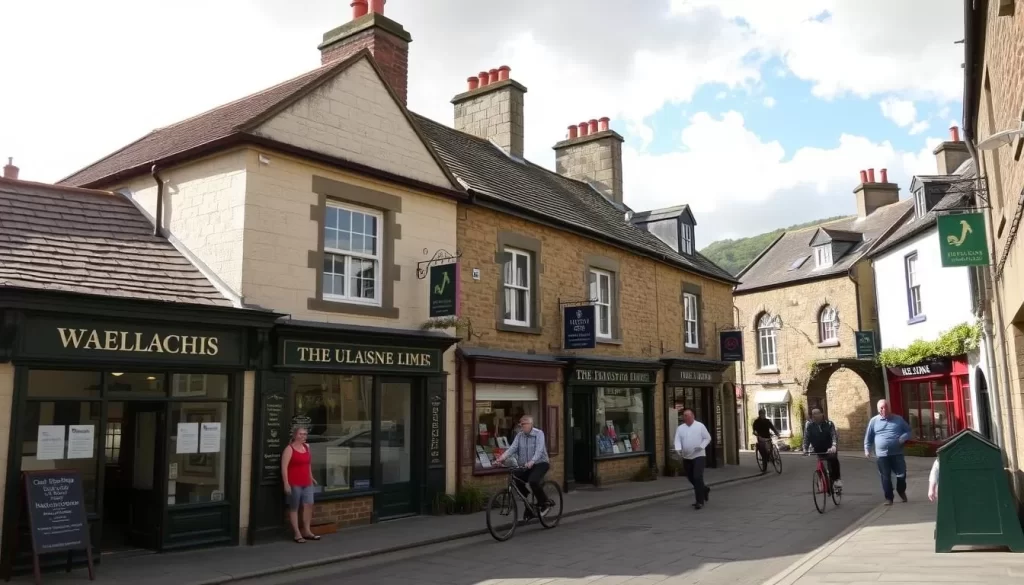✓ Accommodations✓ Flights✓ Rental Cars
In this region, language plays a vital role in shaping cultural identity and community life. The area is known for its bilingual nature, where two primary languages coexist harmoniously. This duality reflects a rich history and a deep connection to tradition.
Recent data from the Census 2021 highlights the number of people who speak these languages. One language is spoken by over 538,000 individuals, while the other remains the most common across the country. This blend creates a unique linguistic profile that sets the region apart.
Understanding this dynamic helps you appreciate the cultural fabric of the area. It also sets the stage for exploring how language influences daily life, education, and policy. Dive in to learn more about this fascinating topic.
Introduction to Language Diversity in Wales
The linguistic landscape here is a vibrant mix of tradition and modernity. Two primary languages coexist, each with its own rich history and cultural significance. This duality creates a unique environment where every person and speaker contributes to the region’s identity.
What Makes Welsh Unique?
Welsh stands out with its Celtic roots and historical evolution. Its grammar and pronunciation are distinct, making it a fascinating study for linguists. The language also holds deep cultural significance, connecting people to their heritage.
For example, Welsh uses mutations, where the initial letter of a word changes based on context. This feature is rare among languages and adds to its uniqueness. Additionally, its survival and revival efforts highlight its importance in modern times.
The Role of English and Other Languages
English serves as the main language for most people here. It’s widely used in education, business, and daily communication. However, Welsh holds official status, ensuring its presence in public life.
Communities in Northern Ireland and other regions also add to the multilingual fabric. Their contributions enrich the cultural tapestry, making the area a hub of linguistic diversity. Together, these languages create a dynamic and inclusive environment.
| Language | Speakers (2021 Census) | Cultural Significance |
|---|---|---|
| Welsh | 538,300 | Official language, Celtic roots |
| English | Over 2.9 million | Main language, widely used |
| Other Languages | Varies | Enriches cultural diversity |
Historical Evolution of Languages in Wales
The journey of languages in this area is a tale of resilience and transformation. Over centuries, the spoken language has evolved through key milestones, reflecting the region’s rich cultural heritage. From ancient roots to modern forms, this evolution tells a story of adaptation and survival.

Key Historical Milestones
One of the earliest forms of language here was Common Brittonic, which dates back thousands of years. By the 7th century, Old Welsh began to emerge, marking a significant shift. The 9th century saw the codification of laws in Welsh, a rare achievement for its time.
In the 19th century, the industrial revolution brought changes, with English becoming more dominant. However, the 20th century witnessed efforts to revive the Welsh language. The 2011 Welsh Language Measure was a pivotal year, reinforcing its official status and ensuring its presence in public life.
Transition from Brittonic to Modern Languages
The transition from Brittonic to modern Welsh was gradual but profound. Early Welsh poets in the 5th to 8th centuries played a crucial role in preserving the language. By the 14th century, literary works like the Mabinogion showcased its richness.
Today, the language continues to thrive, with over 25% of the population able to speak it. This evolution highlights the resilience of the spoken language and its deep connection to cultural identity.
Sign language has also become part of the linguistic scene, adding another layer to the region’s diversity. Despite English being the primary language, these historical changes have shaped a unique and inclusive environment.
Demographic Trends and Census Insights
The 2021 Census provides a detailed snapshot of language use across the country. It reveals how the Welsh language continues to thrive, with over 538,300 people reporting proficiency. This data highlights the resilience of a language deeply rooted in cultural identity.
English remains the main language for most, used widely in education, business, and daily life. However, the presence of Welsh in public spaces and media underscores its importance. Together, these languages create a unique bilingual environment.
2021 Census Data Overview
The latest Census shows a steady increase in Welsh language speakers, particularly among younger generations. This trend reflects successful revival efforts and educational initiatives. It also demonstrates the language’s adaptability in modern times.
In England Wales, the data reveals interesting contrasts. While English dominates, the number of Welsh speakers has grown. This balance highlights the region’s commitment to preserving its linguistic heritage.
Population Shifts and Language Proficiency
Population changes have influenced language trends. Urban areas see higher English usage, while rural regions maintain stronger ties to Welsh. These shifts reflect broader demographic patterns, including migration and cultural exchange.
Language proficiency statistics from 2021 show that over 25% of the population can speak Welsh. This figure is a testament to its enduring relevance. Despite challenges, the language remains a vibrant part of daily life.
Understanding these trends helps you appreciate the dynamic interplay between tradition and modernity. It also sheds light on how languages shape identity and community in this unique part of the country.
Wales, United Kingdom: Official and Widely Spoken Languages
The bilingual nature of this region reflects a deep cultural connection and modern adaptability. Two primary languages coexist, each with its own unique identity and significance. This duality is a testament to the area’s rich heritage and its ability to embrace change.

Legal frameworks like the Welsh Language Act 1993 and the Welsh Language Measure 2011 reinforce the official bilingual status. These laws ensure that both languages are protected and promoted in public life. The latest census data highlights the growing number of speakers, showcasing the resilience of this linguistic tradition.
Dialect differences within the region add another layer of complexity. Variations in pronunciation and vocabulary are often tied to specific areas. These nuances are carefully recorded in census reports, providing a detailed picture of linguistic diversity.
“Language is the road map of a culture. It tells you where its people come from and where they are going.”
Urban and rural areas express the language differently. In cities, English dominates daily interactions, while rural communities maintain stronger ties to the traditional language. This contrast enriches the cultural fabric of the region.
| Language | Legal Framework | Speakers (2021 Census) |
|---|---|---|
| Welsh | Welsh Language Measure 2011 | 538,300 |
| English | Welsh Language Act 1993 | Over 2.9 million |
Understanding these dynamics helps you appreciate the unique linguistic landscape of the area. It’s a blend of tradition and modernity, where every dialect and official language plays a vital role in shaping identity.
Understanding Welsh as an Official Language
Legal frameworks have played a pivotal role in preserving and promoting the Welsh language. Over the years, key legislation has ensured its official status, making it a cornerstone of cultural identity. This section explores the laws that protect Welsh and their impact on daily life.
Legislative Framework and Official Status
The journey to securing Welsh as an official language began with the Welsh Language Act 1993. This law marked a turning point, ensuring that Welsh could be used in public services and legal proceedings. It was a significant step toward equality for the language.
In 2011, the Welsh Language Measure further solidified its status. This legislation made Welsh and English equal in public life, requiring services to be available bilingually. It also established the Welsh Language Commissioner, tasked with promoting and regulating the language.
Impacts of the Welsh Language Measure 2011
The 2011 Measure has had a profound effect on education and public services. Schools now offer Welsh-medium education, helping younger generations speak Welsh fluently. This initiative ensures the language’s survival and growth.
Public services, from healthcare to local government, are now accessible in both languages. This inclusivity benefits residents, ensuring everyone can engage fully in their community. It also fosters a sense of pride and connection to cultural heritage.
Community initiatives have also flourished, with local groups promoting the use of Welsh in daily life. From language classes to cultural events, these efforts strengthen the bond between people and their linguistic roots.
“Language is not just a means of communication; it’s a gateway to culture and identity.”
Legal protections have empowered residents to use Welsh in all aspects of life. Whether in education, work, or leisure, the language is a vibrant part of the community. These efforts ensure that Welsh remains a living, thriving language for generations to come.
The Bilingual Landscape of Wales
Bilingualism in this region is more than just a policy; it’s a way of life. The dual-language framework here ensures that both English and Welsh thrive in public services, education, and daily interactions. This approach reflects a deep commitment to preserving cultural identity while embracing modernity.

Dual Language Policies in Public Services
Public services here are designed to cater to both English and Welsh speakers. From healthcare to local government, bilingual policies ensure accessibility for everyone. This inclusivity strengthens community bonds and fosters a sense of belonging.
For example, official documents and signage are available in both languages. This dual approach not only serves practical needs but also reinforces the importance of the second language in public life. It’s a testament to the region’s dedication to linguistic diversity.
Welsh-Medium Education and Community Efforts
Welsh-medium education plays a crucial role in preserving the language for future generations. Schools here offer immersive programs, ensuring students become fluent in both English and Welsh. This effort is supported by community initiatives that promote bilingualism.
Local groups organize events, language classes, and cultural activities to encourage the use of Welsh. These efforts highlight the region’s unique linguistic heritage and its connection to broader linguistic traditions across the united kingdom.
Being part of the UK influences how bilingualism is approached here. The region’s policies align with national efforts to celebrate language diversity, making it a model for other areas.
Impact of Immigration on Language Trends
Immigration has reshaped the language landscape in the UK, introducing new voices and cultures. Over the past century, the influx of diverse communities has significantly altered the linguistic makeup of the region. This transformation is evident in the growing percentage of people who speak languages other than English and Welsh.
Immigrant groups have brought languages like Polish, Punjabi, and Urdu into the mainstream. These languages now play a vital role in shaping the cultural identity of communities. For example, in urban areas, you’ll often hear multiple languages spoken in schools, workplaces, and public spaces.
Emerging Languages in the United Kingdom
The past few decades have seen a rise in the use of European and Asian languages. Polish, for instance, is now one of the most widely spoken languages after English and Welsh. This shift reflects the growing influence of immigrant communities on the linguistic fabric of the UK.
Changes in person speak dynamics are also notable. Younger generations often grow up bilingual, blending their heritage language with English. This trend fosters a sense of belonging while preserving cultural roots.
| Language | Speakers (2021 Census) | Cultural Impact |
|---|---|---|
| Polish | Over 500,000 | Strong presence in urban areas |
| Punjabi | Approx. 273,000 | Key in South Asian communities |
| Urdu | Approx. 269,000 | Widely used in cultural events |
Immigration has also influenced community cohesion. As highlighted in the paper Migration and English Language Learning after, language learning plays a crucial role in integrating immigrant populations. Programs that support English proficiency help bridge gaps and foster unity.
Looking ahead, the linguistic diversity brought by immigration will continue to evolve. This dynamic interplay of languages enriches the cultural tapestry, making the UK a vibrant hub of global identity.
Regional Variations in Language Use
Language use varies significantly across different areas, reflecting unique cultural and historical influences. From bustling cities to quiet border towns, the way people communicate tells a story of local identity and tradition. Understanding these differences helps you appreciate the rich linguistic tapestry of the region.

Differences Across Welsh Regions and Border Areas
In areas like Carmarthenshire, the status of the Welsh language remains strong. Over 70% of the population here can speak Welsh, making it a cultural cornerstone. In contrast, border areas often see a higher prevalence of English speakers, influenced by proximity to neighboring countries.
Urban centers like Cardiff present a different picture. While English dominates daily interactions, Welsh still holds a significant place in education and public services. This mix creates a dynamic environment where both languages coexist.
Comparative Insights with England, Scotland, and Northern Ireland
When compared to England, the number speaker of Welsh is notably higher in certain regions. For example, in Gwynedd, over 70% of the population speaks Welsh, a stark contrast to English-speaking areas in England. Similarly, Scotland’s Gaelic-speaking communities show parallels in their efforts to preserve a minority language.
Northern Ireland offers another interesting comparison. Here, Irish and Ulster Scots add to the linguistic diversity, much like Welsh does in its region. These similarities highlight the shared challenges and successes in maintaining linguistic heritage.
| Region | Primary Language | Percentage of Speakers |
|---|---|---|
| Carmarthenshire | Welsh | 70% |
| Cardiff | English | 85% |
| Gwynedd | Welsh | 72% |
Factors like migration, education, and cultural initiatives play a key role in shaping these trends. For instance, research shows that language policies in urban areas often differ from those in rural settings, influencing the status of local languages.
These regional variations are not just about numbers. They reflect the deep connection between language and identity, making each region unique in its linguistic landscape.
Statistical Highlights from the 2021 Census
The 2021 Census offers a clear picture of language trends, revealing shifts in proficiency and diversity. It highlights how skill levels in both English and Welsh have evolved, alongside the growing influence of minority and migrant languages. These insights help you understand the region’s linguistic landscape.
English and Welsh Speaker Statistics
According to the Census, over 538,000 people reported being able to speak Welsh, making up 17.8% of the population. This marks a slight decrease from previous years, reflecting ongoing challenges in language preservation. English remains the dominant language, with over 2.9 million speakers.
Younger generations show varying levels of skill in Welsh. For example, 34.3% of children aged 5 to 15 can speak the language, down from 40.3% in 2011. This trend highlights the need for continued efforts in education and community support.
Trends in Minority and Migrant Languages
Immigrant communities have introduced languages like Polish, Punjabi, and Urdu into the region. These languages now play a significant role in shaping cultural identity. For instance, Polish is spoken by over 500,000 people, making it one of the most widely used languages after English and Welsh.
Laws and policies have been instrumental in maintaining bilingual services. The law ensures that both English and Welsh are accessible in public life, fostering inclusivity. Similarly, initiatives to support immigrant languages help integrate diverse communities.
Regional variations also play a role. Urban areas like Cardiff see higher English usage, while rural regions maintain stronger ties to Welsh. These differences reflect broader demographic patterns and the impact of migration.
Understanding these trends helps you appreciate the dynamic interplay between tradition and modernity. It also sheds light on how languages shape identity and community in this unique part of the country.
Conclusion
Language here is more than communication; it’s a bridge to heritage and identity. The dual status of Welsh and English reflects a rich culture shaped by history and modern influences. Over the past decade, census data highlights a steady rise in bilingualism, showcasing the resilience of these traditions.
Immigrant contributions have added new layers to the linguistic tapestry, introducing other languages that enrich the region’s identity. This diversity ensures that the place remains a vibrant hub of european language preservation. Efforts to pass these traditions to the next generation, especially children, are crucial for maintaining this legacy.
Key statistics reveal shifts in language use, with younger generations embracing bilingualism. Looking ahead, the region’s commitment to linguistic diversity promises a bright future. Here, language and culture are not just preserved—they are celebrated, ensuring this unique identity thrives for years to come.
The above is subject to change.
Check back often to TRAVEL.COM for the latest travel tips and deals.






